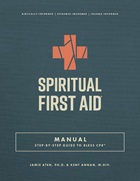An Important Step for Helpers: Find the Sacred Within Before Serving Others.

Helpers are essential to the fabric of our shared humanity. Especially in recent years, helpers have generously jumped in to meet the growing needs within our homes, schools, healthcare facilities, places of worship, businesses, and communities as we’ve individually and collectively navigated complex layers of change and grief.
As helpers, we’re often taught – directly and indirectly – to do and serve and care for others in many ways. Unfortunately, we often reach a point of remembering our finite human capacity, requiring us to refill our own well as we go out and serve others. These limits can be experienced at the core of our physical health, mental health, relationships, and/or spirituality.
Throughout my research, I’ve focused on studying one group of helpers in particular – mental health care providers – and more specifically, their views and behaviors related to ethically considering clients’ religion and spirituality in treatment. This intersection of our spirituality and mental health is important because over 80% of us will meet criteria for a diagnosable mental illness at some point and, at least within the US, over 80% of us consider ourselves to be spiritual. Plus, research over the last few decades has highlighted the nuance of these two areas in our lives, how they positively/negatively intersect in complicated ways, and the importance of considering them in tandem with one another.
What’s been most interesting in my research is mental health care providers with higher degrees of intrinsic religiosity – how deeply motivated they are to live out their faith (regardless of their religious affiliation) – are more inclined to consider the faith of the person they’re helping. Their experiences of the Divine, ways their beliefs motivate their whole approach to life, and how they carry their faith into everyday life impacts their service to others, particularly around attending to clients’ religion/spirituality.
From what I’ve read, experienced, and gathered from others, this pattern extends beyond mental health care providers. Helpers with higher levels of intrinsic religiosity seem more comfortable and willing to consider the unique spiritual lives of those around them. If we want to holistically help those in the world around us, we must create space to nonjudgmentally explore our own unique spiritual landscape. We also must become aware of how those beliefs intersect with our mental health and, truthfully, how this intersection trickles into what we do, so that we can care for others from a place of sacred groundedness.
If we aren’t paying attention to this, we may find it difficult to hold the space needed for the spiritual and mental health journeys of those we serve. Put another way, we must recognize and heal what’s within ourselves in order to truly recognize and heal what’s within this world.
In 2017, after considering these findings, I developed and published Namaste Theory. It’s a grounded theory based on this research with mental health care providers and my humble understanding of the Sanskrit term, namaste, after reading A.K. Krisha Nambiar’s Namaste: It’s Philosophy and Significance in Indian Culture. The term namaste literally translates to mean “I bow to you” but generally translates to “the Sacred in me recognizes the Sacred in you.”
Contemplating this theory within my own life and discussing it with other helpers, I’ve realized it’s a theory meant to help “helpers”—anyone who cares for another human being—recognize the Sacred within themselves. Why? Because when helpers see and serve the Sacred within themselves, they are more likely to see and serve the Sacred within those they care for.
Transparently, I worked for years without seeing and serving the Sacred in myself. I bought into the lie that even if I wasn’t caring for myself holistically, I was still capable of caring for others (hello, pride). I thought I could push past my own exhaustion and continue helping. But this was not the case. The fact is, when our well becomes empty, we fall into exhaustion, resentment, and burnout in our efforts to help others. We need to find a way to keep our wells full.
As an extension of this theory and outlined within The Soul of the Helper are seven stages to seeking the Sacred. These include recognizing the speed at which we’ve been operating as helpers, doing so much for so many for too long. We need to slow down and identify structures to steady us within our slower pace. We then must practice being still to fully see the Sacred within ourselves. And from recognizing the Sacred within, we then shift with compassion for ourselves and others as we serve from a place of knowing we are Beloved.
To the helpers: May you create space to honor and tend to the intersection of spirituality and mental health within. May these seven stages offer you a guide to fully see the Sacred within yourself so you can fully see it in others. For when we connect with the Sacred within ourselves, awakening to the unconditional love prepackaged within us, we can begin to wholly love our neighbors as ourselves and serve from an embodied knowing of our inherent worth.
Holly K. Oxhandler, PhD, LMSW is the Associate Dean for Research and Faculty Development at Baylor University’s Diana R. Garland School of Social Work. She’s the author of The Soul of the Helper, studies the integration of spirituality and mental health, and hosts CXMH: A podcast on faith and mental health. You can learn more about Dr. Oxhandler’s work by visiting hollyoxhandler.com or following @hollyoxhandler on Twitter, Instagram, or Facebook.
The Better Samaritan is a part of CT's
Blog Forum. Support the work of CT.
Subscribe and get one year free.
The views of the blogger do not necessarily reflect those of Christianity Today.






















